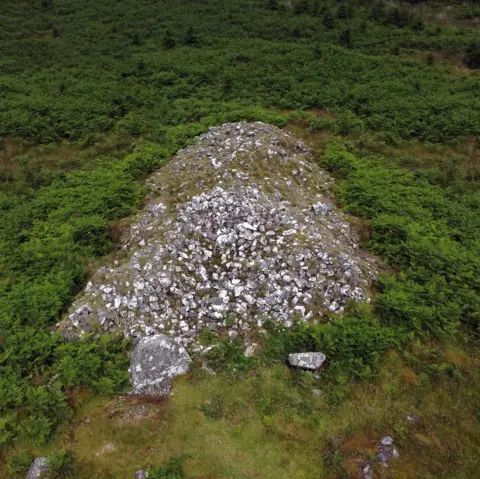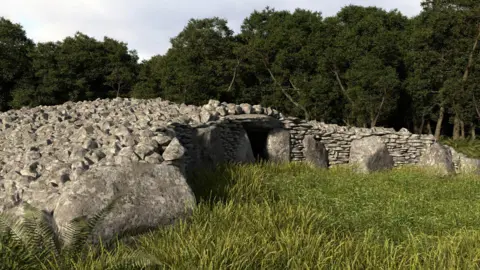Ancient cairn brought back to life with 3D model
Visitors to an ancient chambered cairn in Galloway are being given the chance to see how it might have looked 6,000 years ago.
An enormous pile of stones is all that remains of the structure built by Neolithic farmers at Boreland in Knockman Wood, north of Newton Stewart.
Now a 3D model of the tomb has been brought to life using hundreds of photographs taken from a drone.
A video of how the tomb would have looked can be viewed on an interpretation panel at the site or on the Forestry and Land Scotland (FLS) website.
 FLS
FLSFLS archaeologist Matt Ritchie said: "This visualisation allows us to imagine what this Clyde Cairn - a type of tomb characteristic of south-west Scotland – would have looked like when it was first built.
"The architecture suggests its use as both a tomb for the dead, where people placed the deceased in the chambers within the cairn, and a space for the living, where people could pay their respects within the forecourt."
He said archeological studies could only reveal the "bare bones" of the cairn's story, leaving "much to the imagination".
"They were built by a vibrant ancient society with beliefs, traditions and practices that would seem very strange to us today," he said.
 Marcus Abbott
Marcus AbbottMr Ritchie added that hopefully watching the video and seeing the cairn come to life could answer some questions visitors might have.
"Of the cairns that survive across Scotland, some remain closed, their secrets hidden beneath huge mounds of stone, such as at Boreland in Galloway," he said.
"Others bear the ravages of time, their features masked by rubble and collapse, or have been disturbed by treasure-hunters, their chambers ripped open and exposed.
"Many more have simply been lost over time."
He said the reconstruction at Boreland could hopefully help people "appreciate and understand" the remains of the chambered cairn that survive today.
"It can be difficult to connect with these people and communities from so long ago," he said.
"But their lands are our land and by reimagining and appreciating these ancient structures that they left behind, their story is told and can connect us today with the lives of our ancestors."
